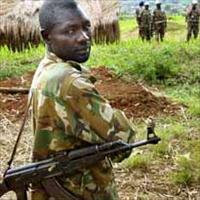DRC: Hidden killers on the loose

"Mines and UXOs [unexploded ordnance] are strewn
all over the countryside," Francesca Fontanini, external relations officer
for the UN Refugee Agency
(UNHCR) in DRC, said. "They are among the most pernicious consequences
of the armed conflict."
The mines and UXOs, according to the agency, could
affect the return and reintegration of an estimated 800,000 people displaced by
years of fighting in North Kivu.
They are also a danger to those who may return home to
areas with unmapped minefields. Children are particularly vulnerable because
some of the weapons look like toys.
"In Dongo, five children who had just [been]
repatriated died after a grenade exploded as they were playing with it,"
Philippe Sondizi Dombale, head of Humanitas Ubangi, a local NGO in Molegbe,
northern DRC, told IRIN in the capital Kinshasa.
"Another boy died in Gbadolite after a landmine he
had been using for several days as a hammer - out of ignorance - blew up in his
face."
More than 892 people have been killed and 1,118 injured
by these deadly weapons since 2001, say activists.
The DRC government ratified the global anti-personnel
mine ban treaty in 2002, but activists say very little has been done to
implement it. And no comprehensive impact surveys have been conducted because
of the volatile security situation across the country in addition to logistical
difficulties.
"Up to now little has been done ... a choice has to
be made [between] the mines continuing to cause casualties and the most urgent
thing - to try to stop it," Harouna Ouedraogo, programme director of the UN Mine Action Coordination
Centre (UNMACC), said.
The government says work is ongoing to address the
plight of victims. "Legislation regarding the rights of victims to
assistance is being drawn up," interior minister Denis Kalume said during
the International Mine Action Day celebrations on 4 April in Kinshasa.
"A focal point will be created for coordination and
we will work closely with our international partners so that national
competency in this area can be achieved," he added.
The government, he
emphasised, was committed to fulfilling its obligations under the Ottawa (Mine Ban) treaty.
Clean-up programmes
According to Mine Advisory Group (MAG) country director Marc Angibeaud,
de-mining efforts through international NGOs such as MAG, Handicap
International and DanChurchAid,
have cleared the countryside of thousands of anti-personnel mines and UXO,
especially in Equateur, Maniema, Katanga and South Kivu provinces.
Work has also been done by the commercial de-mining
company, Mechem.
From June 2007 to January 2008, more than 28,000 sqkm of
land was cleared; over 3,500 weapons, 5,000 UXO and 35,000 items of ammunition
destroyed, and mine education sessions conducted for over 10,000 people.
De-miners have also been trained.
"Clearance activities have not only prevented
accidents from explosions but also freed land for agriculture and rendered safe
many roads and a water source crucial to the villagers’ daily activities,"
MAG noted in a 31 January statement.
"The destruction of the ammunition also means it
will not be available for trafficking - a significant problem in the Great Lakes region - thus contributing to regional
peace-building."
Another NGO, Synergie pour la Lutte Anti Mines (SYLAM),
is teaching internally displaced persons (IDPs) and refugees in North Kivu how to spot half-buried or fully exposed
explosive devices and what to do.
SYLAM has recorded 111 deaths and 127 injuries caused by
these weapons in North Kivu since 2003 -
though none yet inside IDP camps. Together with the UNMACC and other NGOs, it
has identified 51 polluted sites.
Ouedraogo, however, said the achievements so far were
merely the tip of the iceberg. As long as much of the country remained
inaccessible and the people remained poor and ignorant, the problem would
prevail. There were reports, for example, of some people using the explosives
for fishing.
According to the International Campaign to Ban Landmines (ICBL), both rebel
and government forces used anti-personnel mines during the DRC’s numerous
conflicts. There have been no reports of use of anti-personnel mines by
government forces, however, since the DRC signed the landmine treaty.
Since May 2006, an increasing number of small arms and
ammunition, UXO and mines have been handed over to authorities. From 2003 to
May 2006, some 2,244 mines were destroyed.
But the problem remains huge. Surveys by DanChurchAid
covering 153,000 sqkm in Katanga,
So uth Kivu and Maniema, for example, found 171 mined and 583 UXO-contaminated
areas.
De-mining is an expensive business and in DRC, where
infrastructure is lacking, it becomes even more difficult.
The UN
Mission in Congo (MONUC) says work has been slowed down by several key
challenges - survey and mapping sites, provision of adequate assistance to
victims, awareness-raising and the creation of mine legislation. As a result,
landmines and UXOs continue to hamper economic development, and maim and kill
hundreds in the vast country every year.
"Millions in the DRC continue to live with the
daily fear of being killed or disabled," Ross Mountain,
Deputy Special Representative of the UN Secretary-General in the DRC, said on 4
April. "Much has been done, but a lot of challenges remain.
 Back and Next - Back and Next
Back and Next - Back and Next See Also - See Also
See Also - See Also